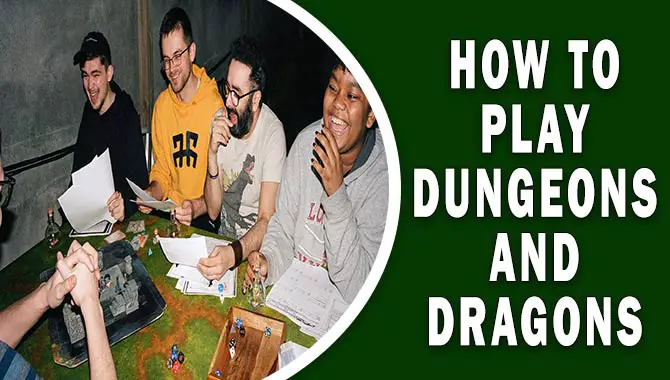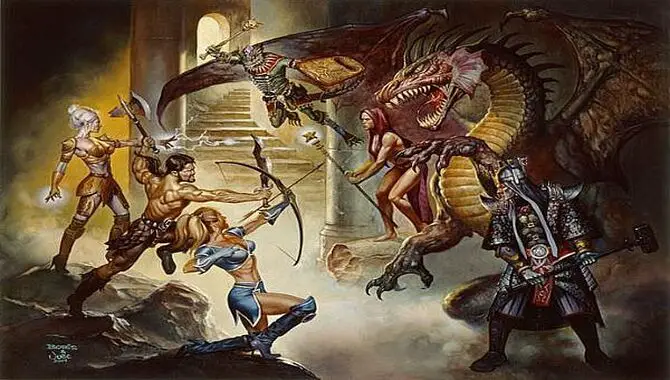Dungeons and Dragons is a role-playing game that has existed since the 1970s. It is typically played with friends, with one person acting as the Dungeon Master or DM.
The DM creates a story and a world for the players to explore, and the players take on the roles of characters interacting with the world and each other.
To get started playing Dungeons and Dragons, you will need a few things:
- A copy of the Dungeons and Dragons rulebook or access to the free basic rules online
- A group of friends who are willing to play
- Some dice (typically a d20, d12, d10, d8, d6, and d4)
Once you have these things, you can start creating characters. Each player will need to create a character sheet, which includes information on their character’s race, class, background, and equipment. Once everyone has created a character, the DM will begin the story.
The DM will describe the scene, and the players will take turns describing what their characters do. The DM decides what happens based on the players’ actions, and the players must work together to overcome their challenges.
Dungeons and Dragons is a great game for people who enjoy telling stories and working together with friends. If you’re looking for a fun and imaginative way to spend time with your friends, try it!

What Is The Basic Premise Of Dungeons And Dragons?
The basic premise of Dungeons and Dragons is that it is a role-playing game in which players take on the role of a character in a fantasy world. The players use their imagination to create their characters and the world around them. The game is played with dice, and other players take on the role of the Dungeon Master, who creates the adventure for the group.
What Do You Need To Play Dungeons And Dragons?
It’s been almost forty years since Dungeons and Dragons were first published, and the game has undergone some major changes, but the core mechanics are still the same. If you’re new to the game or need a refresher, here’s what you need to play:
- A copy of the Dungeons and Dragons rulebooks. The three core rulebooks are the Player’s Handbook, Dungeon Master’s Guide, and Monster Manual. You can also find many online resources, including digital copies of the rulebooks.
- A group of friends who are willing to play. Dungeons and Dragons is a cooperative game, so you’ll need at least one other person to play. The game is usually best with 4-6 players.
- Some way to keep track of the game. Dungeons and Dragons is a complex game with a lot of moving parts. You’ll need some way to keep track of what’s going on: a notebook, index cards, or a digital tool like Google Sheets.
- Dice. A lot of dice. You’ll need at least one set of polyhedral dice, which includes d4, d6, d8, d10, d12, and d20. You can find dice sets online or at your local game store.
You can play a game of Dungeons and Dragons with those four things. Of course, many other resources are available, like miniatures and maps, but those are the basics. So gather your friends, find a copy of the rules, and prepare for some adventure!
How Do You Create A Character For Dungeons And Dragons?
One of the best parts about Dungeons and Dragons is creating a character that is unique to you. It would be best if you did a few key things when creating a character for D&D.
- Come up with a concept for your character. This can be anything from a race and class combination to a backstory or a personality trait you want to portray.
- Once you have a concept, it’s time to start fleshing out the details. For race and class, consult your Dungeon Master’s Guide or the Player’s Handbook for more information. For backstory, start thinking about where your character comes from, their motivations, and what kind of person they are.
- Now, it’s time to start thinking about stats. Every character in D&D has a set of six stats: Strength, Dexterity, Constitution, Intelligence, Wisdom, and Charisma. These stats will determine your character’s success at various tasks in the game. Talk to your Dungeon Master about the stats appropriate for your character concept.
- Once you have your stats, it’s time to choose skills. Skills represent what your character is good at outside of combat. Every character has a certain number of skill points to spend, and each skill costs a certain number of points. Again, consult your Dungeon Master or the Player’s Handbook for more information.
- Now it’s time to choose equipment.
What kind of weapons and armor does your character use? What other gear do they carry?
This is entirely up to you, but keep in mind the kind of character you’re trying to create. A heavily-armored fighter will need different equipment than a nimble rogue.
Creating a character for Dungeons and Dragons can seem daunting, but it’s just a matter of fleshing out a concept and making some choices. With some thought and preparation, you can create a character perfect for your next adventure.
What Is The Role Of The Dungeon Master In Dungeons And Dragons?
The Dungeon Master is the game’s referee and storyteller, and their role is to keep the game moving forward and ensure everyone is having fun. The DM also creates the adventure, decides what challenges the players will face, and describes the world the players are exploring.
A good DM is always prepared and has a quick answer for any rules questions. They should also be able to develop creative solutions to keep the game moving if the players get stuck.
D&D is cooperative, so the DM should be fair and impartial. They should also be willing to listen to players’ suggestions and feedback and make changes to the game if necessary.
The most important thing for a Dungeon Master to remember is that they are there to facilitate the game, and everyone should be having fun. The DM is not doing its job if the players are not enjoying themselves.
Example:
In a recent Dungeons and Dragons game, my group was facing off against a dragon. The dragon proved to be a tough adversary, and we were losing hope.
I, as the Dungeon Master, could have easily let the dragon defeat the party and end the game. However, I decided to allow the players to develop a creative solution.
After some discussion, the players devised a plan to use the dragon’s fire breath against it. This required some quick thinking and teamwork; in the end, the players could defeat the dragon.
Without me, the Dungeon Master, the game would have been over before it began. It’s my job to ensure the players are having fun, which sometimes means bending the rules a bit.
How Do You Resolve Combat In Dungeons And Dragons?

Regarding combat, Dungeons and Dragons have a few different options for resolution. The first and most common option is to use miniatures and a grid to map out the battlefield. Each creature has a certain number of hit points, representing how much damage it can take before being defeated. When a creature takes damage, they mark off the appropriate number of hit points from its total. When a creature reaches 0 hit points, they are defeated.
Another option for combat resolution is to use theater of the mind. This is where the players and the Dungeon Master describe what is happening in the scene, but without using miniatures or a grid. This can be more difficult to keep track of, but it can be more immersive for the players.
The final option for combat resolution is to use a combination of miniatures and theater of the mind. This can be helpful when there are a lot of creatures in a scene or when the scene is particularly complicated.
Whether you choose, combat in Dungeons and Dragons can be exciting and rewarding. It is a great way to test your strategies and see how your party works under pressure.
“I hope you understand now. If you still have questions, please leave a comment below about how to play Dungeons and Dragons.”

I’m a writer and blogger who loves to talk about entertainment, culture, and relationships. I love to share my thoughts and insights on these topics, and I’m always looking for new ways to engage with my readers. I’m also a big fan of learning new things, so I’m always exploring new areas of interest.





